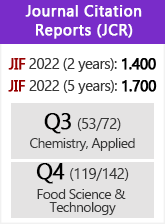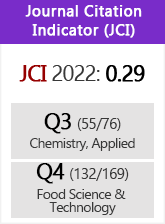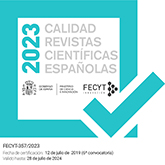A research on the chemical, mineral and fatty acid compositions of two almond cultivars grown as organic and conventional in southeastern Turkey
DOI:
https://doi.org/10.3989/gya.0679211Keywords:
Conventional, Fatty acid, Minerals, Organic, Proximate, Prunus dulcisAbstract
Organic farming is a human and environment friendly production system that is based on soil fertility and food safety without using chemical fertilizers and pesticides in production, aiming to re-establish the deteriorated ecological balance as a result of harmful production practices. Organic products attract the interest of consumers as they are strongly perceived as healthier products compared to conventional food. This study aimed to determine the differences in chemical, mineral, and fatty acid characteristics between conventionally and organically cultivated Ferragnes and Ferraduel almond cultivars. When conventional and organic almonds were evaluated in terms of fatty acids, proximate compositions, and minerals, crude oil and Mg were statistically insignificant, while Cu was significant (P < 0.05) and all others were quite significant (P < 0.001). Total sugar was higher in organic samples compared to conventional samples in both cultivars. The crude oil and linoleic acid (12.93% for Ferragnes and 14.99% for Ferraduel) were higher in conventional samples but oleic acid (78.9% for Ferragnes and 81.08% for Ferraduel) was higher in organic samples. In addition, organic samples contained higher Mg and Fe but lower P, K, Ca, Na, Zn, Mn and Cu when compared with conventional samples. The results indicate that conventionally cultivated almonds present higher mineral content and lower fatty acid value compared to organically cultivated almonds.
Downloads
References
Akan S, Yanmaz R. 2015. Organik gıdaların besin kalitesi ve insan sağlığına etkileri yönünden değerlendirilmesi. Doğu Karadeniz II. Organik Tarım Kongresi, 6-9.
Amaral JS, Cunha SC, Santos A, Alves MR, Seabra RM, Oliveira BP. 2006. Influence of cultivar and environmental conditions on the triacylglycerol profile of hazelnut (Corylus avellana L.). J. Agric. Food Chem. 54 (2), 449-456. https://doi.org/10.1021/jf052133f PMid:16417303
AOAC. 1990. Official Methods of Analysis, 14th edn. Washington, DC: Association of Official Analytical Chemists.
Ballester-Costa C, Sendra E, Fernández-López J, Pérez-Álvarez JA, Viuda-Martos M. 2013. Chemical composition and in vitro antibacterial properties of essential oils of four Thymus species from organic growth. Indus. Crops Prod. 50, 304-311. https://doi.org/10.1016/j.indcrop.2013.07.052
Barreca D, Nabavi SM, Sureda A, Rasekhian M, Raciti R, Silva AS, Mandalari G. 2020. Almonds (Prunus dulcis Mill. DA Webb): a source of nutrients and health-promoting compounds. Nutrients, 12 (3), 672. https://doi.org/10.3390/nu12030672 PMid:32121549 PMCid:PMC7146189
Batun P, Bakkalbaşı E, Kazankaya A, Cavidoğlu İ. 2017. Fatty acid profiles and mineral contents of walnuts from different provinces of Van lake. Gıda, 42 (2) 155-162. https://dergipark.org.tr/tr/download/article-file/272305 https://doi.org/10.15237/gida.GD16062
Crinnion WJ. 2010. Organic foods contain higher levels of certain nutrients, lower levels of pesticides, and may provide health benefits for the consumer. Altern. Med. Rev. 15 (1) 4-12.
Dangour A, Dodhia SK, Hayter A, Allen E, Lock K, Uauy R. 2009. Nutritional quality of organic foods: a systematic review. Am. J. Clinical Nutrit. 90 (3), 680-685. https://doi.org/10.3945/ajcn.2009.28041 PMid:19640946
Davis PA, Iwahashi CK. 2001. Whole almonds and almond fractions reduce aberrant crypt foci in a rat model of colon carcinogenesis. Cancer Lett. 165 (1), 27-33. https://doi.org/10.1016/S0304-3835(01)00425-6
Dieffenbacher A, Pocklington WD. 1992. IUPAC Standart Methods for The Analysis of Oils, Fats and Derivatives, 6th Edition (Fifth Edition Method II.D.19) pgs. 96-102, Pergamon Press Oxford.
FAO, 2020. Food and Agriculture Organisation http://www.fao.org/faostat/en/#home
Foster GD, Shantz KL, Vander Veur SS, Oliver TL, Lent MR, Virus A, Szapary P, Rader DJ, Zemel BS, Gilden-Tsai A. 2012. A randomized trial of the effects of an almond-enriched, hypocaloric diet in the treatment of obesity. Am. J. Clinical Nutrit. 96, 249-254. https://doi.org/10.3945/ajcn.112.037895 PMid:22743313 PMCid:PMC3396441
Fulgoni VL, Abbey M, Davis P, Jenkins D, Lovejoy J, Most M, Sabate J, Spiller G. 2002. Almonds lower blood cholesterol and LDL-cholesterol but not HDL-cholesterol in human subjects: results of a meta-analysis. FASEB J. 16, A981-A982.
Gąstoł M, Domagała-Świątkiewicz I. 2012. Comparative study on mineral content of organic and conventional apple, pear and black currant juices. Acta Sci. Pol., Hortorum Cultus, 11 (3), 3-14. https://www.researchgate.net/publication/258238191
Gomiero T. 2018. Food quality assessment in organic vs. conventional agricultural produce: findings and issues. Appl. Soil Ecol. 123, 714-728. https://doi.org/10.1016/j.apsoil.2017.10.014
Gönül M, Altug T, Boyacıoglu D, Noka Ü, 1988. Gıda Analizleri. Ege Üniversitesi Mühendislik Fakültesi Çogaltma Yayın 64, 179s., İzmir.
Gülnur ETİ, Anıl NK, Kılıç B. 2016. Tüketicilerin organik gıda satın alma tercihlerini etkileyen faktörler. Kırklareli Üniversitesi İktisadi ve İdari Bilimler Fakültesi Dergisi, 5 (2), 93-108. https://dergipark.org.tr/tr/pub/klujfeas/issue/26889/283270
Gülsoy E, Balta F, 2014. Determination of protein, oil and fatty acid contents of some selected almond (Prunus amygdalus Batch) Genotypes from Karacasu and Bozdoğan Yenipazar of Aydın Province. J. Instit. Sci. Technol. 4 (1), 9-14.
Gülsoy E, Şimşek M, 2020. Almond Growing, Dora Publishing. 116 syf. Bursa
Hoefkens C, Sioen I, Baert K, Meulenaer BD, Henauw SD, Vandekinderen I, Devlieghere F, Opsomer A, Verbeke W, Camp JV. 2010. Consuming organic versus conventional vegetables: The effect on nutrient and contaminant intakes. Food Chem. Toxicol. 48, 3058-3066. https://doi.org/10.1016/j.fct.2010.07.044 PMid:20691244
James CS, 1995. Analytical Chemistry of Foods. Publisher Blackie Academic and Professional, London, pp. 176.
Jenkins DJ, Kendall CW, Marchie A, Parker TL, Connelly PW, Qian W, Spiller GA. 2002. Dose response of almonds on coronary heart disease risk factors: blood lipids, oxidized low-density lipoproteins, lipoprotein(a), homocysteine, and pulmonary nitric oxide: a randomized, controlled, crossover trial. Circulation, 106 (11), 1327-1332. https://doi.org/10.1161/01.CIR.0000028421.91733.20 PMid:12221048
Kaplankiran M. 1984. Research on the relationship between natural hormone, carbohydrate and plant nutrient levels and growth of some citrus rootstocks. - PhD Thesis, C. U. Science Institute, Adana, Turkey.
Karaat FE. 2019. Organic vs conventional almond: market quality, fatty acid composition and volatile aroma compounds. Appl. Ecol. Environment. Res. 17 (4), 7783-7793. https://doi.org/10.15666/aeer/1704_77837793
Kester DE, Gradziel TM. 1998. The University of California almond breeding programme: I. historical aspects. Nucis, 7, 8-10.
Lairon D. 2010. Nutritional quality and safety of organic food. A review. Agron. Sustaın. Dev. 30 (1), 33-41. https://link.springer.com/content/pdf/10.1051/agro/2009019.pdf https://doi.org/10.1051/agro/2009019
Lovejoy JC, Most MM, Lefevre M, Greenway FL, Rood JC. 2002. Effect of diets enriched in almonds on insulin action and serum lipids in adults with normal glucose tolerance or type 2 diabetes. Am. J. Clin. Nutrit. 76, 1000-1006. https://doi.org/10.1093/ajcn/76.5.1000 PMid:12399271
Macllwain C. 2004. Organic: is it the future of farming?. Nature, 428, 792-793. https://pubmed.ncbi.nlm.nih.gov/15103346/ https://doi.org/10.1038/428792a PMid:15103346
Magkos F, Arvaniti F, Zampelas A. 2006. Organic food: buying more safety or just peace of mind? A critical review of the literature. Critical Rev. Food Sci. Nutrit. 46, 23-56. https://doi.org/10.1080/10408690490911846 PMid:16403682
Magnusson M K, Avrola A, Hursti Koivisto UK, Aberg L, Sjoden PO. 2001. Attitudes towards organic foods among Swedish consumers. British Food J. 103, 209-226. https://doi.org/10.1108/00070700110386755
Mele MA, Islam MZ, Kang HM, Giuffrè AM. 2018. Pre-and post-harvest factors and their impact on oil composition and quality of olive fruit. Emirates J. Food Agric. 30 (7), 592-603. https://doi.org/10.9755/ejfa.2018.v30.i7.1742
Mushtaq A, Khaliq M, Saeed A, Azeem MW, Ghania JB. 2015. Almond (Prunus amygdalus L.): A review on health benefits, nutritional value and therapeutic applications. Int. J. Chem. Biochem. Sci. 8, 103-106. https://www.researchgate.net/profile/Jihene-Ben-Ghnia/publication/342153576
Pussemier L, Larondelle Y, Van Peteghem C, Huyghebaert A. 2006. Chemical safety of conventionally and organically produced foodstuffs: a tentative comparison under Belgian conditions, Food Control 17, 14-21. https://www.favv-afsca.be/scientificcommittee/publications/articles/_documents/organic_final.pdf https://doi.org/10.1016/j.foodcont.2004.08.003
Rabadán A, Álvarez-Ortí M, Gómez R, Pardo-Giménez A, Pardo JE. 2017. Suitability of Spanish almond cultivars for the industrial production of almond oil and defatted flour. Scientia Horticult. 225, 539-546. https://www.cabdirect.org/cabdirect/abstract/20173322066 https://doi.org/10.1016/j.scienta.2017.07.051
Samman S, Chow JW, Foster MJ, Ahmad ZI, Phuyal JL, Petocz P. 2008. Fatty acid composition of edible oils derived from certified organic and conventional agricultural methods. - Food Chem. 109 (3), 670-674. https://doi.org/10.1016/j.foodchem.2007.12.067
Sánchez-Bel P, Egea I, Martínez-Madrid MC, Flores B, Romojaro F. 2008. Influence of irrigation and organic/inorganic fertilization on chemical quality of almond (Prunus amygdalus cv. Guara). J. Agric. Food Chem. 56 (21), 10056-10062. https://doi.org/10.1021/jf8012212 PMid:18847209
Saura Calixto F, Canellās J. 1982. Mineral composition of almond varieties (Prunus amygdalus L.). Z. Lebensm. Unters. Forsch. 174 (2), 129-131. https://doi.org/10.1007/BF01045828
Simsek M. 2021. Evaluation of some physical properties and fatty acid compositions of native almondgenotypes grown in Adiyaman province of Turkey. Fresenius Environmental Bulletin, 30 (06A), 6349-6359.
Simsek M, Gulsoy E, Yavic A, Arikan B, Yildirim Y, Olmez N, Erdogmus B, Boguc F. 2018. Fatty acid, mineral and proximate compositions of various genotypes and commercial cultivars of sweet almond from the same ecologıcal condıtıons. Appl. Ecol. Environment. Res. 16 (3), 2957-2971. http://www.aloki.hu/pdf/1603_29572971.pdf https://doi.org/10.15666/aeer/1603_29572971
Soares DJ, Vasconcelos PHMD, Camelo ALM, Longhinotti E, Sousa PHMD, Figueiredo R WD. 2013. Prevalent fatty acids in cashew nuts obtained from conventional and organic cultivation in different stages of processing. Food Sci. Technol. 33, 265-270. https://doi.org/10.1590/S0101-20612013005000050
Venkatasubramanian C. 2011. Nutritional quality and acceptability of organic and conventional foods. - Indian J. Sci. Technol. 4 (3), 361-365. https://doi.org/10.17485/ijst/2011/v4i3.41
Vrastil JA. 2018. A Comparison of Mineral Content in Conventionally and Organically Grown Almonds. California State University, Long Beach.
Wang SY, Chen CT, Sciarappa W, Wang CY, Camp MJ. 2008. Fruit quality, antioxidant capacity, and flavonoid content of organically and conventionally grown blueberries, J. Agric. Food Chem. 56, 5788-5794. https://doi.org/10.1021/jf703775r PMid:18590274
Welna M, Klimpel M, Zyrnicki W. 2008. Investigation of major and trace elements and their distributions between lipid and non-lipid fractions in Brazil nuts by inductively coupled plasma atomic optical spectrometry. Food Chem. 111, 1012-1015. https://doi.org/10.1016/j.foodchem.2008.04.067
Woese K, Lange D, Boess C, Bogl KW. 1997. A comparison of organically and conventionally grown foods-results of a review of the relevant literature. J. Sci. Food Agric. 74 (3), 281-293. https://doi.org/10.1002/(SICI)1097-0010(199707)74:3<281::AID-JSFA794>3.0.CO;2-Z
Worthington V. 2001. Nutritional quality of organic versus conventional fruits, vegetables, and grains. J. Alternat. Complement. Med. 7, 161-173. https://doi.org/10.1089/107555301750164244 PMid:11327522
Yada S, Lapsley K, Huang G. 2011. A review of composition studies of cultivated almonds: Macronutrients and micronutrients. J. Food Composit. Anal. 24 (4-5), 469-480. https://doi.org/10.1016/j.jfca.2011.01.007
Zorb C, Langenkamper G, Betsche T, Niehaus K, Barsch A. 2006. Metabolite profiling of wheat grains (Triticum aestivum L.) from organic and conventional agriculture. J. Agric. Food Chem. 54 (21), 8301-8306. https://doi.org/10.1021/jf0615451 PMid:17032043
Published
How to Cite
Issue
Section
License
Copyright (c) 2022 Consejo Superior de Investigaciones Científicas (CSIC)

This work is licensed under a Creative Commons Attribution 4.0 International License.
© CSIC. Manuscripts published in both the printed and online versions of this Journal are the property of Consejo Superior de Investigaciones Científicas, and quoting this source is a requirement for any partial or full reproduction.All contents of this electronic edition, except where otherwise noted, are distributed under a “Creative Commons Attribution 4.0 International” (CC BY 4.0) License. You may read here the basic information and the legal text of the license. The indication of the CC BY 4.0 License must be expressly stated in this way when necessary.
Self-archiving in repositories, personal webpages or similar, of any version other than the published by the Editor, is not allowed.
















